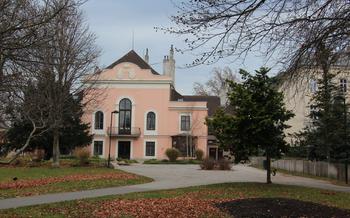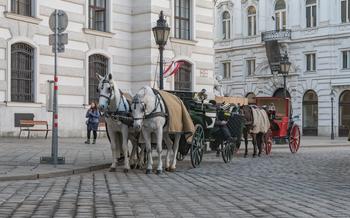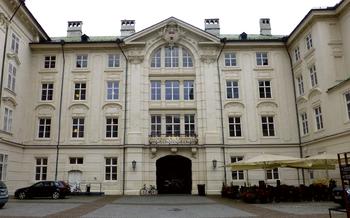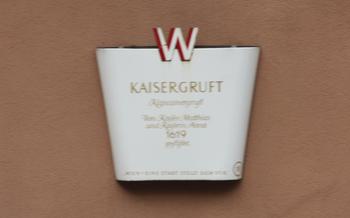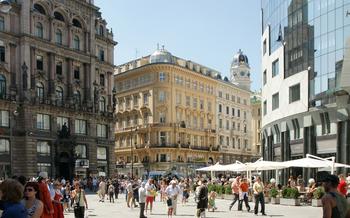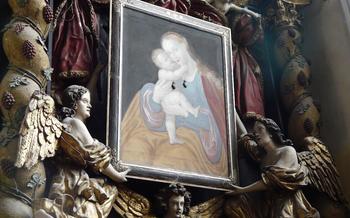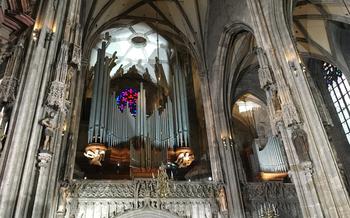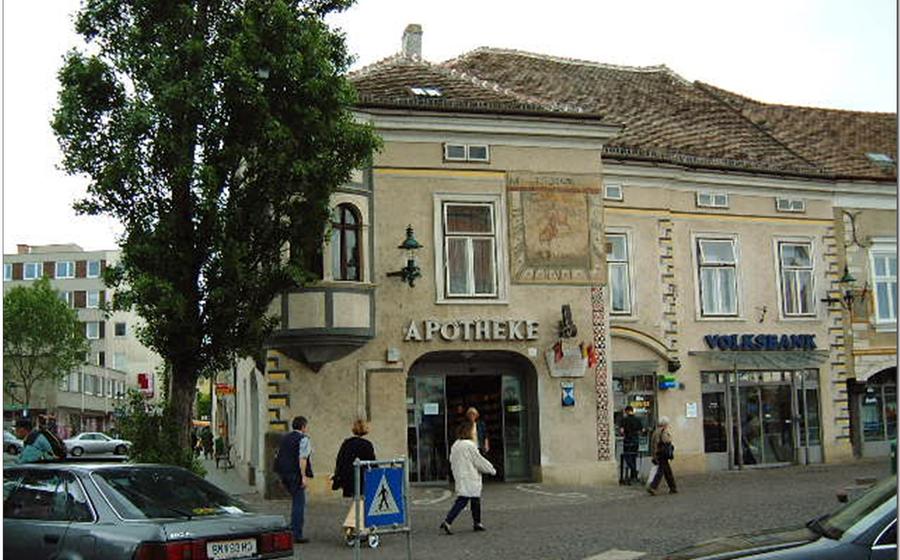
Imperial Treasury Vienna (Kaiserliche Schatzkammer)
- A Journey Through Imperial Splendors
- Treasures of the Holy Roman Empire
- The Insignia of Power: Scepters, Orb, and Sword
- Habsburg Dynastic Jewels: A Reflection of Imperial Grandeur
- The Burgundian Treasure: A Legacy of Opulence and Cultural Exchange
- The Order of the Golden Fleece
- Religious Relics and Treasures: Divine Artifacts of Habsburg Devotion
- The Imperial Treasury Today
- Highlights of the Collection
- Interactive Displays and Multimedia: Embracing Technology to Enhance the Visitor Experience
- The Habsburg Myth and Legacy
- Photography and Social Media
- Insider Tip: Unveiling Hidden Gems and Capturing Unique Perspectives
A Journey Through Imperial Splendors
Unveiling the opulent history of the Habsburg dynasty, the Imperial Treasury Vienna (Kaiserliche Schatzkammer) stands as a testament to the grandeur and power of one of Europe's most illustrious royal families. Nestled within the Hofburg Palace complex, the treasury houses a dazzling collection of imperial regalia, jewels, and sacred treasures that narrate the Habsburgs' rise to prominence and their reign over the Holy Roman Empire.
The Imperial Treasury serves as a symbol of imperial power, showcasing the Habsburgs' vast wealth, artistic patronage, and diplomatic prowess. Through its exquisite artifacts, visitors embark on a journey through centuries of imperial history, gaining insights into the lives, ceremonies, and traditions of the Habsburg monarchs who shaped the course of European history.
Treasures of the Holy Roman Empire
Delve into the heart of imperial opulence as you explore the crown jewels and scepters of the Holy Roman Emperors, meticulously preserved within the Imperial Treasury. Witness the grandeur of the Imperial Crown of Austria, a testament to Habsburg power and artistry. Crafted from pure gold and adorned with precious stones, this magnificent crown radiates an aura of majesty that befits its imperial lineage. Discover the symbolic meanings intricately woven into the imperial regalia, each element representing a facet of imperial authority and divine right. These treasures, imbued with historical significance, invite you on a journey through the grandeur and pageantry of the Holy Roman Empire.
The Insignia of Power: Scepters, Orb, and Sword
The Imperial Treasury Vienna holds an impressive collection of imperial scepters, each symbolizing the vast power and authority of the Holy Roman Emperors. These elaborate ceremonial objects, crafted from precious metals and adorned with jewels, served as tangible representations of the emperor's sovereignty.
Among the most notable scepters is the Imperial Scepter, also known as the Scepter of Charlemagne. This magnificent artifact dates back to the 10th century and is believed to have been used by Charlemagne himself. Its intricate design features a golden orb topped by a cross, symbolizing the emperor's divine authority.
Another significant scepter is the Scepter of Otto III, created in the 10th century. This exquisite piece is adorned with a variety of precious stones, including rubies, sapphires, and emeralds. Its intricate carvings depict scenes from the life of Christ, highlighting the close connection between the Holy Roman Empire and the Catholic Church.
In addition to the scepters, the Imperial Treasury also houses the Imperial Orb, a symbol of the emperor's worldly power. This spherical object, made of gold and encrusted with jewels, represents the emperor's dominion over the earthly realm.
The Imperial Sword, another symbol of imperial authority, is also on display. This magnificent weapon, with its intricately decorated hilt and scabbard, was used in imperial coronations to bestow knighthood upon the newly crowned emperor.
These insignia of power played a vital role in imperial ceremonies and rituals, embodying the majesty and authority of the Holy Roman Emperors. They served as tangible reminders of the emperor's divine right to rule and his responsibility to protect and guide his subjects.
Habsburg Dynastic Jewels: A Reflection of Imperial Grandeur
Adorned with the finest gemstones and crafted with meticulous precision, the Habsburg dynastic jewels stand as a testament to the opulence and artistry that defined the Habsburg court. These exquisite creations, worn by emperors, empresses, and archduchesses, served as powerful symbols of imperial power and prestige.
Among the most captivating pieces are the tiaras, necklaces, earrings, and brooches, each boasting a unique design and an intriguing history. The Imperial Tiara, crafted in gold and adorned with over 2,000 diamonds, is a masterpiece of imperial jewelry, symbolizing the grandeur and majesty of the Habsburg dynasty.
Discover the stories behind the precious stones that adorn these jewels, from the legendary Star of Africa diamond to the resplendent emeralds that once graced the necklines of Habsburg empresses. Each gem carries with it a tale of intrigue, romance, and power struggles that unfolded within the opulent halls of the Habsburg court.
Marvel at the intricate designs and exceptional craftsmanship of the imperial jewelers, who transformed precious metals and gemstones into wearable works of art. Their mastery of enamelwork, engraving, and stone setting brought to life the Habsburgs' vision of imperial splendor, creating jewels that would become treasured heirlooms for generations to come.
The Burgundian Treasure: A Legacy of Opulence and Cultural Exchange
Nestled among the resplendent collection of the Imperial Treasury, the Burgundian Treasure stands apart as a testament to the Habsburgs' intricate ties with the court of Burgundy. Originating from the dukes of Burgundy, this exquisite ensemble of goldsmithing masterpieces found its way to the Habsburg dynasty through strategic marriages and political alliances.
The Burgundian Treasure boasts an array of stunning pieces that reflect the exceptional craftsmanship and artistic prowess of Burgundian goldsmiths. Marvel at the intricate reliquaries adorned with precious stones, the finely worked gold and enamel goblets, and the elaborate tableware that once graced the tables of the Burgundian court.
Each object within the Burgundian Treasure carries a tale of cultural exchange and diplomatic maneuvering. The goldsmiths, inspired by the flourishing artistic centers of Europe, fused various styles and techniques, creating a unique blend that became synonymous with the Burgundian aesthetic.
Immerse yourself in the fascinating narratives surrounding the acquisition of these treasures, and witness firsthand the enduring legacy of the Habsburgs' diplomatic efforts to consolidate their power and influence across Europe. The Burgundian Treasure remains a testament to the enduring impact of cultural exchange and the legacy of the Habsburg dynasty.
The Order of the Golden Fleece
Established in 1430 by Philip the Good, Duke of Burgundy, the Order of the Golden Fleece was a prestigious chivalric order that played a significant role in Habsburg diplomacy and statecraft. The order's elaborate ceremonies and rituals reflected the Habsburgs' desire to assert their power and influence in Europe.
Visitors to the Imperial Treasury can admire the exquisite collars, badges, and jewels worn by members of the Order of the Golden Fleece. These magnificent pieces of craftsmanship showcase the exceptional skills of Burgundian goldsmiths and the wealth and prestige of the Habsburg dynasty.
The insignia of the Order of the Golden Fleece features a golden ram suspended from a gold chain. The ram symbolizes the mythical creature that was said to have guided Jason and the Argonauts in their quest for the Golden Fleece. The order's motto, "Pretium Laborum Non Vile," translates to "The Reward of Labor is Not Vile," emphasizing the importance of perseverance and dedication in achieving one's goals.
The Order of the Golden Fleece was not only a symbol of honor and prestige but also a powerful political tool. Membership in the order was highly sought after by European nobility, and the Habsburgs used it to strengthen their alliances and expand their influence. The order's ceremonies and rituals were carefully designed to impress and awe visitors, showcasing the Habsburgs' wealth, power, and authority.
Religious Relics and Treasures: Divine Artifacts of Habsburg Devotion
Beyond the dazzling jewels and imperial regalia, the Imperial Treasury Vienna also houses a captivating collection of religious relics and treasures. These sacred objects, deeply revered by the Habsburg dynasty, offer a glimpse into their profound faith and the role they played as protectors of the Catholic Church.
Among the highlights of this collection is the Holy Lance, believed to be the lance that pierced the side of Jesus during the Crucifixion. This revered relic holds immense religious significance and was often carried by Habsburg emperors during solemn processions and coronations.
Another notable treasure is the Imperial Cross, crafted from rare and precious materials and intricately adorned with jewels. It served as a symbol of imperial authority and was used in religious ceremonies and rituals.
The treasury also boasts a collection of reliquaries, elaborate containers that house the remains of saints and martyrs. These beautifully crafted objects, adorned with gold, silver, and gemstones, showcase the Habsburgs' devotion to the cult of saints and their belief in the power of relics.
Visitors can also admire a collection of religious vestments and liturgical objects, such as chalices, monstrances, and crosiers. These ornate and exquisitely crafted items were used by Habsburg rulers and high-ranking clergy during religious ceremonies, demonstrating the Habsburgs' commitment to the Catholic faith and their role as patrons of the Church.
Explore this sacred collection to gain a deeper understanding of the Habsburgs' religious beliefs, their close ties with the Catholic Church, and the role of religion in shaping the dynasty's history and legacy.
The Imperial Treasury Today
The Imperial Treasury has undergone a remarkable transformation over the centuries, evolving from a repository of imperial wealth to a world-renowned museum. In 1923, it opened its doors to the public, allowing visitors to delve into the opulent history of the Habsburg dynasty. Today, the treasury stands as a testament to the grandeur and artistry of a bygone era.
Modern conservation techniques ensure the preservation of these priceless artifacts. State-of-the-art display cases and climate-controlled environments protect the treasures from the ravages of time. Interactive exhibits and multimedia presentations bring the imperial past to life, immersing visitors in the stories and significance of each object.
The Imperial Treasury is not merely a museum; it is a gateway to understanding the Habsburg dynasty's profound influence on Austrian and European history. It is a place where visitors can marvel at the exquisite craftsmanship, learn about the symbolic meanings of imperial regalia, and gain insights into the lives of the Habsburg rulers who once wielded these treasures.
Highlights of the Collection
The Imperial Treasury Vienna boasts a collection of treasures that are not only historically significant but also aesthetically stunning. Among the must-see items is the Imperial Crown of Austria, crafted in 1602 for Emperor Rudolf II. This masterpiece of goldsmithing features precious stones, enamel, and pearls and is a symbol of imperial authority.
Another highlight is the Burgundian Treasure, comprising precious objects collected by the wealthy and powerful Dukes of Burgundy. The collection includes gold and silver vessels, jewelry, and tapestries, showcasing the exceptional craftsmanship of Burgundian artisans.
For those seeking unique and lesser-known treasures, the treasury holds a narwhal tusk that was once believed to be the horn of a mythical unicorn. The Sword of Charlemagne, dating back to the 10th century, is another hidden gem, symbolizing the emperor's role as protector of Christendom.
Personal recommendations include the Order of the Golden Fleece, a prestigious chivalric order founded by Philip the Good, Duke of Burgundy, in 1430. The elaborate collars and badges worn by its members are a testament to the order's status and influence.
These highlights offer a glimpse into the opulence and grandeur of the Habsburg dynasty, leaving a lasting impression on visitors and providing a deeper understanding of imperial history and culture.
Interactive Displays and Multimedia: Embracing Technology to Enhance the Visitor Experience
The Imperial Treasury Vienna elevates the visitor experience through a range of interactive displays and multimedia presentations that bring the imperial past to life. These innovative exhibits allow visitors to engage with the history and significance of the treasures in a dynamic and immersive way.
Touchscreens and interactive panels provide detailed information about each artifact, including its history, symbolism, and craftsmanship. Visitors can zoom in on intricate details, learn about the materials and techniques used, and discover the stories behind the objects.
Multimedia presentations transport visitors back in time, recreating historical events and ceremonies associated with the imperial regalia. These immersive experiences offer a glimpse into the grandeur of imperial coronations, the opulent Habsburg court, and the rich cultural heritage of Austria.
By incorporating interactive elements and multimedia technology, the Imperial Treasury Vienna creates a truly engaging and memorable experience for visitors of all ages. These innovative displays enhance understanding, spark curiosity, and leave a lasting impression on those who explore the wonders of this historic institution.
The Habsburg Myth and Legacy
The Habsburg dynasty, with its 640-year reign over the Austrian Empire, left an indelible mark on the nation's history, culture, and identity. Their legacy extends beyond the magnificent treasures housed in the Imperial Treasury. The Habsburgs were patrons of the arts, architecture, and music, contributing to Vienna's reputation as a cultural capital. Their influence can be seen in the city's grand palaces, opulent churches, and world-renowned opera houses.
Myths and legends intertwined with the Habsburg dynasty, adding to their mystique. The Habsburg Jaw, a distinctive protruding lower jaw, was believed to be a sign of their divine right to rule. The legend of the "Iron Crown" of Charlemagne, said to have been made from nails from the True Cross, further enhanced their aura of legitimacy.
The Habsburg reign had a profound impact on Austrian society. Their emphasis on Catholicism shaped the nation's religious landscape, while their intermarriages with other European royal families created a complex web of alliances and rivalries. The Habsburg legacy lives on in Austria's national identity, its cultural heritage, and the enduring fascination with its imperial past.
Photography and Social Media
Capturing the opulence of the Imperial Treasury through photography is an enriching experience. While preserving these memories, it's important to adhere to the museum's regulations. Flash photography is strictly prohibited, as it can damage the delicate artifacts. Instead, utilize natural light or the museum's lighting to capture the treasures' beauty.
To share your experiences with the world, social media platforms offer a great outlet. Tag the Imperial Treasury Vienna (@kaiserlicheschatzkammer) and use the official hashtag (#ImperialTreasury) to connect with other enthusiasts. Remember to be respectful of the museum's environment and other visitors when taking photographs and using your devices.
For those seeking unique perspectives, venturing beyond the main galleries is recommended. Explore the hidden corners and lesser-known exhibits to discover captivating details and intriguing stories. Patience and a keen eye will reward you with exceptional photographic opportunities.
Insider Tip: Unveiling Hidden Gems and Capturing Unique Perspectives
As you wander through the Imperial Treasury, keep an eye out for secret spots that offer unique perspectives and photo opportunities. One such spot is the "Geheime Schatzkammer" (Secret Treasury), a hidden vault that houses some of the most precious and rarely seen treasures. Here, you can admire exquisite jewels, ornate goldsmith work, and historical artifacts up close, away from the crowds.
Another insider tip is to visit the Imperial Treasury during the off-season or on weekdays to avoid the tourist throngs. This will allow you to enjoy a more intimate and immersive experience, with ample time toじっくりと(carefully) savor the details of each treasure.
Finally, don't miss the opportunity to engage with the knowledgeable and passionate staff members who are always ready to share fascinating stories and insights about the collection. They can point you towards hidden gems and lesser-known narratives that may not be immediately apparent to the casual visitor.
